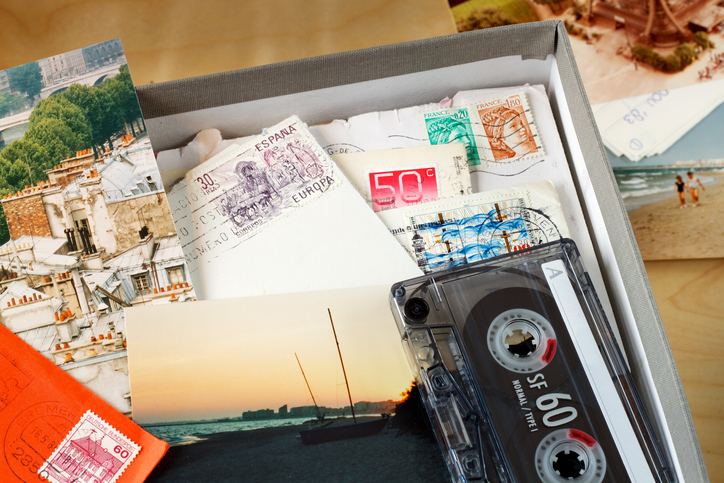Are You Using the Power of Retro Fundraising?
Summer is coming to an end. Schools are about to re-open.
Remember that first day back at school? It was full of excitement and eagerness. You had a new bag, new supplies, and you probably couldn’t wait to see your friends.
Or maybe it was a bit different for you. Maybe you were shy, or scared, or anxious. Regardless of our specific memories, right now we’re all feeling the same: nostalgic.
Science tells us when we’re feeling nostalgic, we’re more likely to give.

Why does nostalgia trigger giving?
It makes us happier. Despite its bittersweet “taste”, nostalgia actually brings elation and euphoria. And being in a positive mood has long been linked to increased pro-social behaviour.
It makes us view ourselves in a positive light. Reminiscence of the past has a positive effect on our self-image. Most probably in an effort to be consistent with a positive self-image and reinforce it further, we’re more willing to engage in prosocial behaviour after nostalgic memories.
It evokes a sense of moral purity. Children are regarded as innocent and pure in most countries. When werecall memories from our childhood, this may also trigger a morally pure image of ourselves – a morally clean and innocent self – with which we might want to keep up.
It promotes social closeness. Memories of the past usually include people close to us which enhances the feeling of belonging and strengthens social bonds. This promotes prosocial behaviour because members of a community are expected to help and care for each other.
It increases feelings of empathy. In a series of studies, nostalgia was found to increase feelings of empathy and consequently charitable behaviour.
It increases our sense of meaning. Feeling nostalgic can increase meaning in life which can increase motivation to pursue your life goals. Who you are – your different identities –determine what your goals are. One way to achieve those goals is by supporting a non-profit aligned with your identity.
Based on all this evidence, it makes sense for fundraisers to test a nostalgic touch in their fundraising strategy to see if it’ll increase helping behaviour.
In the consumer world, retro marketing isn’t new. Nostalgia is used to make a modern product attractive and influence purchase behaviour. Similarly, retro fundraising – our term, not an official name for it – can use copy, photos, or offers that evoke nostalgic feelings. And there are three ways to achieve this, each tapping into a different type of nostalgia:
- Collective Nostalgia. People of the same generation share common experiences. For example, the latest generation has no idea what a cassette is. But show an image of a cassette to someone born in the ‘80s and you’ll instantly induce nostalgic thoughts. Fundraisers can target different generational segments – that’s actually a great use of those kind of segmentations – and tap into a different collective memory to trigger nostalgia.
- Historical Nostalgia. Do you ever feel you were born into the wrong generation? Or feel a yearning for a time in the past that you have not actually experienced? Now you know what this type of nostalgia is called. Admittedly, not everyone is prone to this kind of nostalgia. But for those who are, offers that give them a chance to experience the distant past will be very attractive to them. Think of charities organizing retro fundraising events like historical re-enactments, or people hosting retro fundraisers like a ‘20s fashion party.
- Personal Nostalgia. Organizations that have a personal relationship with the donor e.g. education institutions have an advantage. They can appeal to the donors’ personal nostalgic feelings about their experience with them and help them re-experience the past. For example, when contacting their alumni, universities could share videos, photos or anecdotes of events that happened in their school years. The alumni will feel valued but also nostalgic about their college campus lives, which will increase feelings of warmth and trust and ultimately giving towards the organization.
Caution (once again!) : One-size-doesn’t-fit-all.
You guessed it. Different people have different nostalgia proneness, that is the tendency to indulge in nostalgic memories. Older people, or people who score high in the personality trait neuroticism seem to be more prone to nostalgia. But also the same person might feel more or less nostalgic under different circumstances e.g. when feeling lonely, or when coping with the loss of someone, or when dealing with a lockdown (sigh!).
Regardless, it seems that looking in our past urges us to create a better future. So when you map out your fundraising strategy, leave some room for some nostalgia testing.
Kiki



Hallo und herzlichen Dank für die Anregungen zum Retro-Fundraising. Wo finde ich die genannten Studien, die belegen, dass nostalgische Gefühle das Gebe-Verhalten positiv beeinflussen. Viele Grüße Elisabeth
Hello and thank you very much for the suggestions for retro fundraising. Where can I find the studies mentioned, which prove that nostalgic feelings positively influence the give behavior. Best regards, Elisabeth
Hi Elizabeth. The links in the post will take you to the research.
Roger